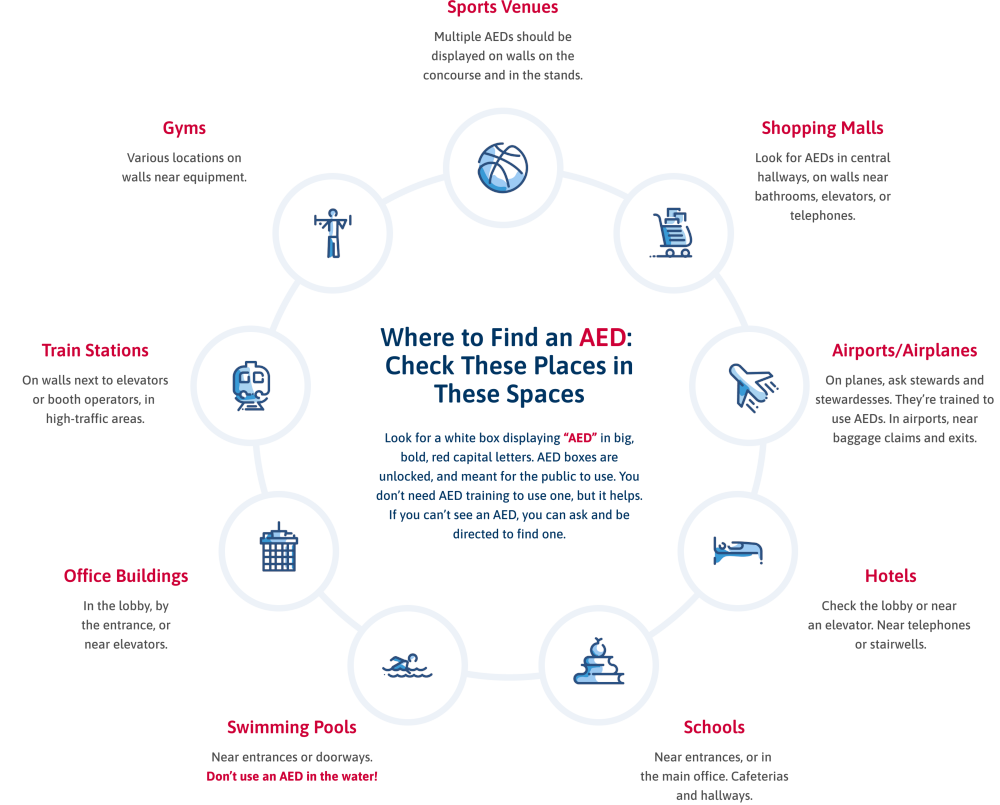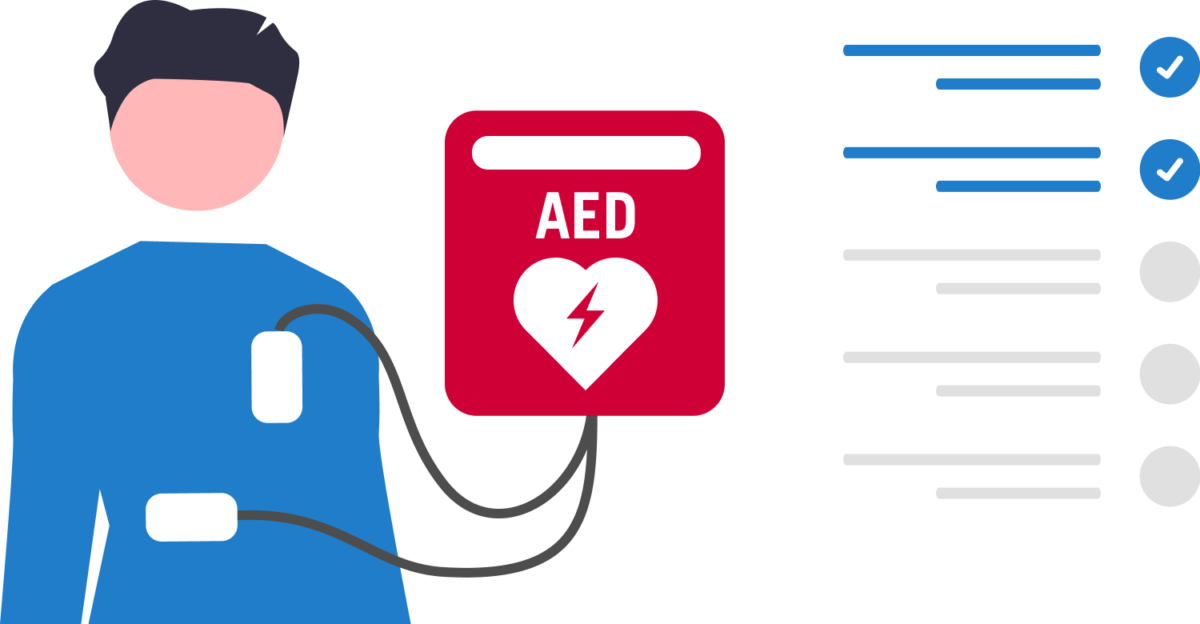Table of Contents
When a person collapses, has no pulse, and isn’t breathing, most people’s first instinct is to step in and provide CPR.
Knowing how to use an AED can increase
a victim’s chances of survival
You’ve likely seen a red plastic box mounted in public areas or signs that say “AED Device Available on Site” — and if you haven’t, consider locating one next time you’re out.
Automated external defibrillators (AEDs) generally come with two sets of sticky pads, one for children (a person one to seven years old) and a set of patches for adults.
But many people misunderstand how to use an AED and are unsure of what, exactly, it’s intended to do. Read on for everything you should know about using an AED to save a life.
What an AED Is
An AED may seem a relatively new invention, however, according to the NIH, the first AEDs were invented in the 1960s by Frank Partridge. Although these machines were originally bulky 70 kilogram devices, today’s AEDs are portable and much more user-friendly.
As implied in the name, the device provides an electric shock to the heart to defibrillate the heart back into a normal rhythm.
The automatic portion of the name refers to the analysis these machines do through their sticky patches to measure a person’s heart rhythm and instructs the user to apply the proper electrical shock if appropriate.
There are also internal versions of these machines that need to be surgically placed for those with high risk factors or history of cardiac arrest; however, whether or not you know how to use an AED, rest assured that external AEDs can be safely used with relative ease.
Knowing where to find an AED can save precious seconds
Get a sense of where to look, wherever you are, with this handy infographic.

How to Use an AED
When a person collapses and is believed to be in cardiac arrest, immediate action needs to be taken. After all, the sooner the victim receives intervention, the higher their chances of survival.
The American Heart Association suggests the use of an AED
paired with CPR to help improve the chance of survival
Here’s how to use an AED in five simple steps:
- Place the victim flat on his or her back when it’s safe to do so, taking steps to avoid further injuries to the neck or spine.
- Check for a pulse. If you can’t find a pulse, a second person should be sent to retrieve the AED while a primary bystander begins chest compressions. Once the AED has been retrieved, the victim should have their bare chest exposed quickly so that chest compressions aren’t interrupted.
- Locate the appropriate sticky patches, and attach them to the machine. While continuing chest compressions, The machine should have pictures of how to use an AED, which can be a helpful guide in an emergency situation.
- Ensure the victim’s chest is dry, and attach the patches. The first patch will be located between the person’s right pectoral muscle and their collar bone. The second will be applied below the left pectoral muscle near their left side.
- Follow the machine’s directions. The machine should have a clearly identified button that will be pressed. The machine will analyze the person’s heart rate and give a clear indication of whether an electric shock is needed to return the victim’s heart to normal rhythm.
Before delivering the shock, it’s essential to make sure no one is touching the victim. Following the shock, begin performing CPR immediately starting with chest compressions, and monitor the victim until medical help arrives.
How to Use an AED on a Woman
An AED is designed to be used the same way on a man and a woman. Of course, since men and women are built differently, placing pads properly can become a delicate issue.
A recent survey by the American Heart Association has shown that men have a 23% higher chance of survival from cardiac arrest, simply due to the fact that they receive CPR from a bystander 45% of the time.
Women only receive bystander CPR 39% of the time
One factor that keeps some women from receiving lifesaving assistance are questions around the manipulation of breast tissue and whether or not a woman’s bra needs to be removed in order to properly use an AED, especially if that bra contains metal in the form of an underwire.
If it’s a question of breast tissue, it can be moved out of the way with the hands to place a sticky pad.
If a bra is in the way, it can be removed and placed to the side so that the electricity from the AED won’t redirect itself around the heart and miss it.
How Two Rescuers Use an AED
When two rescuers are together, they work in concert, moving as quickly and efficiently as possible. One might perform chest compressions while the other prepares the AED for use.
Then, they cycle back and forth performing CPR compressions and administering defibrillation as needed.
One rescuer may administer rescue breaths via bag valve mask while the other performs chest compressions in between electric shocks.
The goal is to maximize the chances of survival by minimizing any delays between actions and keeping circulation going until the victim can be brought to a hospital.
How to Use an AED on a Child
Children who die of sudden cardiac arrest usually have a heart arrhythmia, a condition that disrupts the rhythm of the heart, causing it to beat too quickly or slowly.
To help prevent losses like these, understanding how to use an AED on a child is important.
When using an AED on a child, it requires a lower level of energy to defibrillate their smaller hearts. In most machines, the energy is decreased from 150 joules in adults to 50 joules for a child.
Check your machine to see how this attenuation, or reduction, is calibrated; in some machines, it might be pre-set into a separate set of child electrode pads, or you might have to activate it using a button or key.
Knowing how to use an AED on a child can save precious lives
Here are the steps for how to use an AED on a child:
- Place the child flat on his or her back when it’s safe to do so, taking steps to avoid further injuries to the neck or spine.
- Check for a pulse. If you can’t find a pulse, a second person should be sent to retrieve the AED while a primary bystander begins chest compressions. Once the AED has been retrieved, the victim should have their bare chest exposed quickly so that chest compressions aren’t interrupted.
- Locate the appropriate sticky patches and attach them to the machine. While continuing chest compressions, The machine should have pictures of how to use an AED, which can be a helpful guide in an emergency situation.
- Ensure the victim’s chest is dry and attach the patches. Place one adhesive electrode pad on the child’s upper right chest, above the breast, Then place the second pad on the lower left chest below the armpit.
- Follow the machine’s directions. The machine should have a clearly identified button that will be pressed. The machine will analyze the person’s heart rate and give a clear indication of whether an electric shock is needed to return the victim’s heart to normal rhythm.
How to Use an AED on an Infant
When using an AED on an infant, the placement of the patches differs from using an AED on a child.
In this case, you’ll want to put the first pad on an infant’s upper left chest, with the second pad on their back. Then, follow these steps:
- Place the child flat on his or her back when it’s safe to do so, taking steps to avoid further injuries to the neck or spine.
- Check for a pulse. If you can’t find a pulse, a second person should be sent to retrieve the AED while a primary bystander begins chest compressions. Once the AED has been retrieved, the victim should have their bare chest exposed quickly so that chest compressions aren’t interrupted.
- Locate the appropriate sticky patches and attach them to the machine. While continuing chest compressions, The machine should have pictures of how to use an AED, which can be a helpful guide in an emergency situation.
- Ensure the victim’s chest is dry and attach the patches. Place one adhesive electrode pad on the child’s upper right chest, above the breast, Then place the second pad on the lower left chest below the armpit.
- Follow the machine’s directions. The machine should have a clearly identified button that will be pressed. The machine will analyze the person’s heart rate and give a clear indication of whether an electric shock is needed to return the victim’s heart to normal rhythm.
AED FAQs
Is there any risk of the electric shock jumping to metal or on to another person?
We’re often asked, when discussing how to use an AED, whether there’s any risk of the electric shock jumping from the pad to another person or metal close by.
While we understand the thought process behind this concern, our experienced staff has not yet heard of an AED arcing from the patch to another person or to an item like an underwire bra.
This fact further illustrates the safety built into these life-saving devices.
Can you use an AED in water?
Definitely not. Although AEDs are often stored in places like pools, saunas, and spas, you want to make sure you, the victim, and the surface you’re working with are as dry as possible, keeping the electrode pads away from a damp or conductive surface.
Modern-day AED patches have specifically designed conductive adhesives and insulating foam around the edges to help prevent any accidental shockings, but that doesn’t protect against the very real threat of water damage.
Do I keep the electrode pads on?
Yes, even after a victim has been successfully defibrillated. This is to prevent the return of VF, or ventricular fibrillation. The AED will continually monitor the victim for the return of VF. The AED should be left on until emergency personnel have arrived and assume responsibility for the victim.
What if I’m not sure when to use an AED?
You can use this rule of thumb: only use an AED on a person who also needs CPR – that is, a person who is unresponsive and not breathing.
The Importance of Knowing How to Use an AED
AEDs can be used by the average citizen, so even if you’ve never used one — and you hope to never have to — it’s a great idea to locate the AED at your work or other areas you frequent often.
Once you know how to use an AED, being able to locate one at a moment’s notice can be a crucial next step in preparedness.
Not sure where to look? Never be caught off guard again with our comprehensive guide on where to find an AED.
Knowing how to use an AED in tandem with CPR can significantly improve chances of survival
At ProTrainings, we stand behind our belief that training saves lives and provide high-quality training from experienced professionals who have used the very techniques they teach.
Contact us today to learn more about our group and remote-staff CPR certification programs.
Sources
- https://www.ncbi.nlm.nih.gov/pmc/articles/PMC555899/
- https://www.heart.org/-/media/files/health-topics/answers-by-heart/what-is-an-aed.pdf
- https://www.youtube.com/watch?v=MjXiWU_qYic
- https://www.revivecpr.com/saving-women/
- https://www.youtube.com/watch?v=FTDB9oPWZMg
- https://www.youtube.com/watch?v=B4Dcnw9CLYc
- https://www.zoll.com/products/aeds/aeds-for-public-access
